AIC : tomb figures from Ancient Mexico
About 5 years ago, the museum hosted a large exhibit of terracotta figures from western Mexico -- the areas west of Mexico city, through Jalisco, and over to the Pacific coast -- and from centuries -- even a millenium -- earlier than classic Maya civilization.

It was less stately -- but more intense --- less divine -- but more human -- similar to how Etruscan figures differ from the later Roman/Hellenistic sculpture --- and it looks like I prefer those earlier periods -- on both sides of the Atlantic. Several early 20th C. sculptors and collectors shared this preference -- and by way of comparison, the exhibit also included some small pieces by Henry Moore that used similar elements -- though less deftly -- demonstrating, at least to me, the achievement in these apparently simple little pieces. Most of my favorites seem to come from Colina, in the Comala phase dated 200BC to 300 AD.
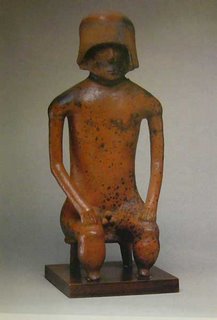
I know guys like this -- the ones who do their jobs -- don't ask any questions -- but in private put on the headphones and listen to space music. Am I the only one who feels that these pieces are connected to drug culture ? I just wonder how much of daily life -- or especially ritual life -- was conducted while under the influence. There's something psychedelic about those distorted proportions and colorful surfaces -- or -- maybe I'm just having a sixties flashback .

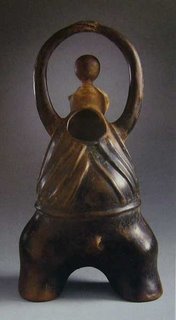
this is a sculptor -- rather than a figure -- at play.
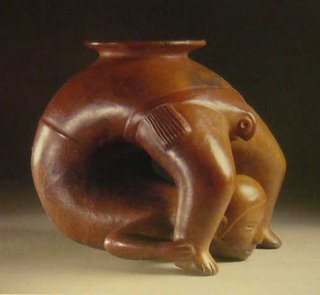
Here's my picks from the AIC's permanent installation -- and all of them come from this same period. (they do have a large Mayan architectural relief -- which might once have been awesome -- but it's condition has suffered badly over the past thousand years)
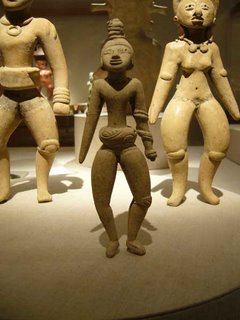
Love these dancers -- especially in comparison to each other -- each different, but moving to the same rhythm -- so I'm thinking of the "California Raisins" -- as they danced to "Heard it through the Grapevine"
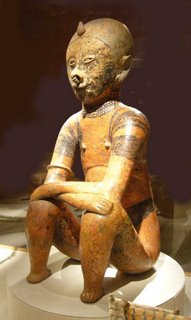
This weird guy called a "chieftain" -- and I've noted how their chieftains/leaders are sitting rather than standing tall -- sitting , perhaps, because they're so stoned, they'd fall over if they tried to stand.

Not an especially good looking woman -- but probably quite vigorous.
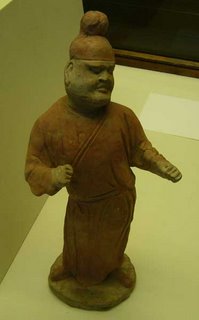
This mime is not Mexican -- he's Tang Dynasty Chinese (from the Field Museum) -- but he reminded me of the Mexican acrobat pictured further above. All these things come from tombs -- and I like the idea of providing for eternal entertainment.

It was less stately -- but more intense --- less divine -- but more human -- similar to how Etruscan figures differ from the later Roman/Hellenistic sculpture --- and it looks like I prefer those earlier periods -- on both sides of the Atlantic. Several early 20th C. sculptors and collectors shared this preference -- and by way of comparison, the exhibit also included some small pieces by Henry Moore that used similar elements -- though less deftly -- demonstrating, at least to me, the achievement in these apparently simple little pieces. Most of my favorites seem to come from Colina, in the Comala phase dated 200BC to 300 AD.

I know guys like this -- the ones who do their jobs -- don't ask any questions -- but in private put on the headphones and listen to space music. Am I the only one who feels that these pieces are connected to drug culture ? I just wonder how much of daily life -- or especially ritual life -- was conducted while under the influence. There's something psychedelic about those distorted proportions and colorful surfaces -- or -- maybe I'm just having a sixties flashback .


this is a sculptor -- rather than a figure -- at play.

Here's my picks from the AIC's permanent installation -- and all of them come from this same period. (they do have a large Mayan architectural relief -- which might once have been awesome -- but it's condition has suffered badly over the past thousand years)

Love these dancers -- especially in comparison to each other -- each different, but moving to the same rhythm -- so I'm thinking of the "California Raisins" -- as they danced to "Heard it through the Grapevine"

This weird guy called a "chieftain" -- and I've noted how their chieftains/leaders are sitting rather than standing tall -- sitting , perhaps, because they're so stoned, they'd fall over if they tried to stand.

Not an especially good looking woman -- but probably quite vigorous.

This mime is not Mexican -- he's Tang Dynasty Chinese (from the Field Museum) -- but he reminded me of the Mexican acrobat pictured further above. All these things come from tombs -- and I like the idea of providing for eternal entertainment.


0 Comments:
Post a Comment
<< Home